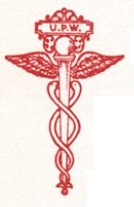Related Research Articles
A trade union, often simply called a union, is an organization of workers who have come together to achieve many common goals, such as protecting the integrity of their trade, improving safety standards, and attaining better wages, benefits, and working conditions through the increased bargaining power wielded by the creation of a monopoly of the workers. Trade unions typically fund the formal organization, head office, and legal team functions of the trade union through regular fees or union dues. The delegate staff of the trade union representation in the workforce are made up of workplace volunteers who are appointed by members in democratic elections.
The Mackintosh or raincoat is a form of waterproof raincoat, first sold in 1824, made out of rubberised fabric.

The Transport and General Workers' Union was one of the largest general trade unions in the United Kingdom and Ireland – where it was known as the Amalgamated Transport and General Workers' Union (ATGWU) to differentiate itself from the Irish Transport and General Workers' Union – with 900,000 members. It was founded in 1922 and Ernest Bevin served as its first general secretary.

The Ceramic and Allied Trades Union (CATU) was a trade union representing pottery workers in the United Kingdom.
The National and Local Government Officers' Association was a British trade union representing mostly local government "white collar" workers. It was formed in 1905 as the National Association of Local Government Officers, and changed its full name in 1952 while retaining its widely used acronym, NALGO. By the late 1970s it was the largest British white collar trade union, with over 700,000 members. It was one of three unions which combined to form UNISON in 1993.
The Trades and Labor Congress of Canada was a Canada-wide central federation of trade unions from 1886 to 1956. It was founded at the initiative of the Toronto Trades and Labour Council and the Knights of Labor. It was the third attempt at a national labour federation to be formed in Canada: it succeeded the Canadian Labour Union which existed from 1873 to 1877 and the Canadian Labour Congress which held only one conference in 1881.

The Union of Communication Workers (UCW) was a trade union in the United Kingdom for workers in the post office and telecommunications industries.

The National Union of Dyers, Bleachers and Textile Workers (NUDBTW) was a trade union in the United Kingdom.
The Akron rubber strike of 1936 was a strike by workers against rubber factory owners in Akron, Ohio.
The National Union of General Workers (NUGW) was an early general union in the United Kingdom, the most important general union of its era.
The National Amalgamated Union of Labour (NAUL) was a general union in the United Kingdom.

The National Union of Tailors and Garment Workers (NUTGW) was a trade union in the United Kingdom.

The National Union of Scottish Mineworkers (NUSW) is a trade union in Scotland, founded in 1894 as the Scottish Miners Federation. It joined the Miners' Federation of Great Britain, and in 1914 changed its name to National Union of Scottish Mineworkers. It survives as the National Union of Mineworkers.

The United Garment Workers' Trade Union (UGWTU) was a trade union in the United Kingdom.
The Federated Rubber and Allied Workers' Union of Australia was an Australian trade union which existed between 1909 and 1988. The union represented workers employed in manufacturing rubber, plastic, electrical cable, adhesive and abrasive products in Australia.

The Trades Union Congress (TUC) is a national trade union centre, a federation of trade unions in England and Wales, representing the majority of trade unions. There are 48 affiliated unions, with a total of about 5.5 million members. The current General Secretary is Frances O'Grady.
The Wire Workers' Union was a trade union in England which existed between 1840 and 1991. It represented workers involved in the manufacture of wire.
The Association of Building Technicians (ABT) was a trade union representing architects, surveyors and related workers in the United Kingdom.
The Waterproof Garment Workers' Trade Union was a trade union representing workers involved in making waterproof clothing in the United Kingdom.